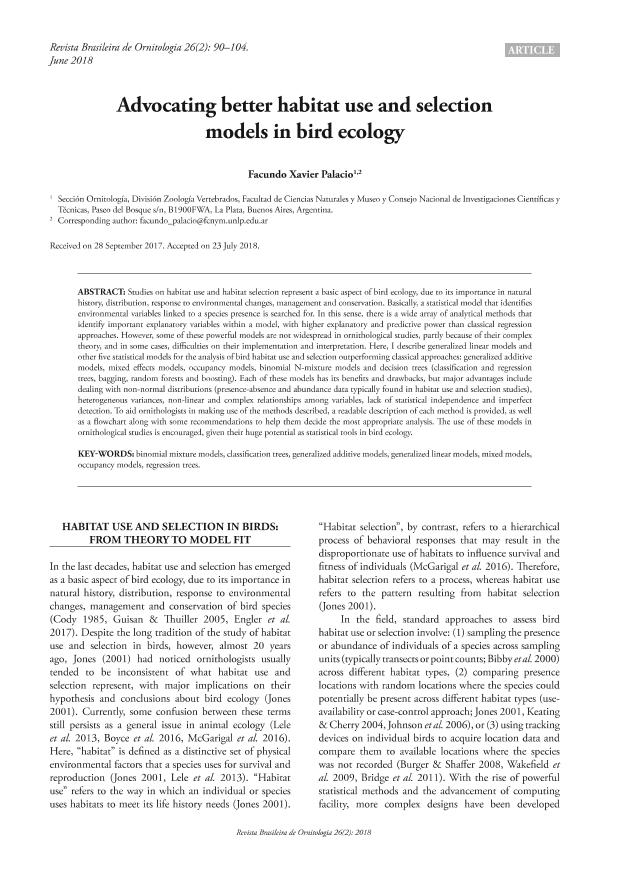Mostrar el registro sencillo del ítem
dc.contributor.author
Palacio, Facundo Xavier

dc.date.available
2020-03-18T16:08:07Z
dc.date.issued
2018-06
dc.identifier.citation
Palacio, Facundo Xavier; Advocating better habitat use and selection models in bird ecology; Sociedade Brasileira de Ornitologia; Ararajuba; 26; 2; 6-2018; 1-15
dc.identifier.issn
0103-5657
dc.identifier.uri
http://hdl.handle.net/11336/100039
dc.description.abstract
Studies on habitat use and habitat selection represent a basic aspect of bird ecology, due to its importance in natural history, distribution, response to environmental changes, management and conservation. Basically, a statistical model that identifies environmental variables linked to a species presence is searched for. In this sense, there is a wide array of analytical methods that identify important explanatory variables within a model, with higher explanatory and predictive power than classical regression approaches. However, some of these powerful models are not widespread in ornithological studies, partly because of their complex theory, and in some cases, difficulties on their implementation and interpretation. Here, I describe generalized linear models and other five statistical models for the analysis of bird habitat use and selection outperforming classical approaches: generalized additive models, mixed effects models, occupancy models, binomial N-mixture models and decision trees (classification and regression trees, bagging, random forests and boosting). Each of these models has its benefits and drawbacks, but major advantages include dealing with non-normal distributions (presence-absence and abundance data typically found in habitat use and selection studies), heterogeneous variances, non-linear and complex relationships among variables, lack of statistical independence and imperfect detection. To aid ornithologists in making use of the methods described, a readable description of each method is provided, as well as a flowchart along with some recommendations to help them decide the most appropriate analysis. The use of these models in ornithological studies is encouraged, given their huge potential as statistical tools in bird ecology.
dc.format
application/pdf
dc.language.iso
eng
dc.publisher
Sociedade Brasileira de Ornitologia

dc.rights
info:eu-repo/semantics/openAccess
dc.rights.uri
https://creativecommons.org/licenses/by/2.5/ar/
dc.subject
BINOMIAL MIXTURE MODELS
dc.subject
CLASSIFICATION TREES
dc.subject
GENERALIZED ADDITIVE MODELS
dc.subject
GENERALIZED LINEAR MODELS
dc.subject
MIXED MODELS
dc.subject
OCCUPANCY MODELS
dc.subject
REGRESSION TREES
dc.subject.classification
Ecología

dc.subject.classification
Ciencias Biológicas

dc.subject.classification
CIENCIAS NATURALES Y EXACTAS

dc.title
Advocating better habitat use and selection models in bird ecology
dc.type
info:eu-repo/semantics/article
dc.type
info:ar-repo/semantics/artículo
dc.type
info:eu-repo/semantics/publishedVersion
dc.date.updated
2020-03-04T15:40:20Z
dc.journal.volume
26
dc.journal.number
2
dc.journal.pagination
1-15
dc.journal.pais
Brasil

dc.journal.ciudad
Pelotas, RS
dc.description.fil
Fil: Palacio, Facundo Xavier. Consejo Nacional de Investigaciones Científicas y Técnicas; Argentina. Universidad Nacional de La Plata. Facultad de Ciencias Naturales y Museo. División Zoología de Vertebrados. Sección Ornitología; Argentina
dc.journal.title
Ararajuba

dc.relation.alternativeid
info:eu-repo/semantics/altIdentifier/url/http://www.revbrasilornitol.com.br/BJO/article/view/260203
Archivos asociados
